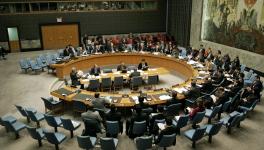Why is Trouble Brewing in Sri Lanka's Tea Industry?
Sri Lanka is the largest supplier of orthodox teas, exporting more than 95% of its production.
With Sri Lanka in the throes of its worst ever economic crisis, its prosperous tea industry has taken a hit, with exports dropping drastically.
The island nation's ongoing financial and political crisis has crippled its lucrative tea industry which is regarded as crucial for the country's economy.
Though Ranil Wickremesinghe was chosen by lawmakers as Sri Lanka's President on Wednesday, many worry that the turbulence may continue and the economic crisis worsen if normalcy does not return soon enough.
Tea industry takes a blow
For the last three months, the country has been gripped by severe shortages of fuel, food and other essentials after its foreign reserves dried up. The country owes more than $51 billion (€49.95 billion) to foreign lenders and inflation runs at more than 50%.
Industry insiders point out that before the country's economic crisis, tea exports accounted for US$1.3 billion annually and 5% of all global tea production, but this has now dropped drastically to its lowest level in over two decades.
Sri Lanka produces around 300 million kilograms of tea annually and is predominantly an orthodox tea producer. Indeed, Sri Lanka is the largest supplier of orthodox teas, exporting more than 95% of its production.
Stakeholders insist the country's emergency has trickled down to job losses and rambling tea estates are already witnessing rising social tensions, as those without work in Colombo return home.
Prolonged power cuts have led to plucked tea leaves withering and getting spoilt as it affects quality.
"Production of tea has fallen by 18% and this has been largely on account of shortage of fertilizers and fuel. We need a course correction soon and there should be no major disruptions here on," Jayantha Karunaratne, Chairman of the Colombo Tea Traders Association, told DW.
The tea industry, now over 150 years in existence, is faced with a crisis which mainly affects the smaller stakeholders of the sector who are responsible for about 75% of tea production.
Karunaratne pointed out that the government needed to take positive action to restore fuel and stabilize fertilizer supplies due to the danger of losing the global tea market.
Roshan Rajadurai, member of the Planters' Association of Ceylon, also concurred with the view that shortage of fuel had vastly hampered transportation of raw materials as work from the estates to the factories had come to a halt.
"Tea is a big foreign exchange earner. At stake is the future of nearly 500,000 small holders and it could affect over two and a half million people employed in or engaged in direct and indirect jobs related to the tea industry,” Rajadurai told DW.
"The plantation sector alone is responsible for at least 10% of the population and in this respect, they have to ensure that the workers are looked after as they are totally dependent on their managements," he added.
According to various estimates seven prosperous tea-growing districts, 264 private tea factories, and another 258 government-run factories were operating with severe problems.
Faulty policies adopted
Many pin the current crisis affecting the tea industry on adopting wrong policies without consulting industry experts.
In 2015, former President Maithripala Sirisena banned the import and use of glyphosate, and other chemical fertilizers, without any reported consultation with the Tea Research Institute or stakeholder representatives. No alternative herbicides were proffered.
"Then, in 2021, the [recently] ousted President Gotabaya Rajapaksa, again with no consultation with the industry, banned not only all chemical fertilizers, but also all pesticides and herbicides. Officials who disagreed with this policy were fired or forced out of their jobs," Rohan Pethiyagoda, former chairman of the Sri Lanka Tea Board told DW.
The loss of revenue from tea and other export crops played a part in the rapid economic decline of Sri Lanka.
The rationale behind the controversial move was to make Sri Lankan farming 100% organic. Though the ban on fertilizers has been lifted, the country has since run out of foreign exchange.
"The reduction we see in tea production is largely a result of that folly. Rice was worse hit, with a 40% decline year on year," he added.
Given the severe crisis gripping the tea industry in Sri Lanka, industry experts felt it would open an opportunity for the Indian tea industry to tap the market.
Recently, Indian Tea Exporters Association Chairman Anshuman Kanoria said the industry is expecting Sri Lanka's crop to be around 15% lower this year because of its economic decline.
"We have already seen international buyers, who need Sri Lankan tea for their blend, have started paying higher prices as tea from that country has become [more] expensive by around 10-20%," Kanoria told the media.
However, the Sri Lankan industry believes that might be a tough call as international buyers have an allegiance to the island nation's tea and their insignia. Given the right impetus and with a hope of political stability returning, the tea industry can bounce back, they believe.
"While Indian tea has its appeal, what we produce is artisanal orthodox tea and the taste and flavor is entirely different. That's why it has its unique charm," said the Planters' Association of Ceylon member Rajadurai.
"On the bright side, tea is now back to being Sri Lanka's most important net foreign exchange earner, and agrochemicals are beginning to trickle back into the market," said Pethiyagoda.
But all agree that the climb to the targeted annual production of 300 million kilograms is still many years away, as is the country's goal to export most of its tea in value-added form.
Edited by: John Silk
Get the latest reports & analysis with people's perspective on Protests, movements & deep analytical videos, discussions of the current affairs in your Telegram app. Subscribe to NewsClick's Telegram channel & get Real-Time updates on stories, as they get published on our website.
























